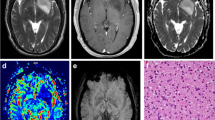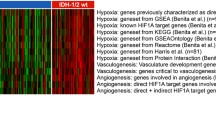Abstract
1p19q LOH has been shown to predict radio- and chemosensitivity and prolonged survival in oligodendrogliomas (OLs). We have recently shown that magnetic resonance perfusion-weighted imaging (MR-PWI) may be useful in predicting the histopathological grade or cytogenetic type of oligodendroglial neoplasms. MR-PWI allows noninvasive determination of relative tumor blood volume (rTBV), which may reflect the degree of neoplastic angiogenesis and metabolism. The present study was aimed to correlate rTBV to the angiogenic markers and EGFR expression in oligodendroglial tumors with 1p/19q LOH or 1p LOH (Group 1) and 1p19q intact alleles or 19q LOH (Group 2), respectively. In WHO grade II neoplasms, Group 1 showed significantly greater rTBV than Group 2 (P = 0.013). However, the differences between Group 1 and Group 2 were not significant in grade III tumors. Probe-based real-time RT-PCR analyses showed that 12% of Group 2 high-grade tumors with intact 1p19q exhibited dramatic EGFR overexpression (designated EGFR-high). Grade III neoplasms showed a significantly higher rTBV than grade II neoplasms. Group 1 tumors showed significantly higher rTBV than Group 2 tumors, independent of the EGFR-high subtype. Real-time RT-PCR analyses showed increased expression of VEGF, CD31 and CD105 in Group 1 tumors as compared to Group 2 tumors, excluding the EGFR-high subtype. Multivariable linear regression analysis showed a significant association of rTBV with 1p19q LOH, and expression of EGFR and VEGF. Therefore, the combined use of extensive molecular profiling and advanced MR imaging modalities may improve the accuracy of tumor grading, provide prognostic information, and has the potential to influence treatment decisions.




Similar content being viewed by others
References
Cairncross JG, Ueki K, Zlatescu MC, Lisle DK, Finkelstein DM, Hammond RR et al (1998) Specific genetic predictors of chemotherapeutic response and survival in patients with anaplastic oligodendrogliomas. J Natl Cancer Inst 90:1473–1479. doi:10.1093/jnci/90.19.1473
Carmeliet P (2004) Manipulating angiogenesis in medicine. J Intern Med 255:538–561. doi:10.1111/j.1365-2796.2003.01297.x
Cha S, Lu S, Johnson G, Knopp EA (2000) Dynamic susceptibility contrast MR imaging: correlation of signal intensity changes with cerebral blood volume measurements. J Magn Reson Imaging 11:114–119. doi:10.1002/(SICI)1522-2586(200002)11:2<114::AID-JMRI6<3.0.CO;2-S
Chawla S, Wang S, Wolf RL, Woo JH, Wang J, O’Rourke DM et al (2007) Arterial spin-labeling and MR spectroscopy in the differentiation of gliomas. AJNR Am J Neuroradiol 28:1683–1689. doi:10.3174/ajnr.A0673
Ducray F, Idbaih A, de Reynies A, Bieche I, Thillet J, Mokhtari K et al (2008) Anaplastic oligodendrogliomas with 1p19q codeletion have a proneural gene expression profile. Mol Cancer 7:41. doi:10.1186/1476-4598-7-41
Duff SE, Li C, Garland JM, Kumar S (2003) CD105 is important for angiogenesis: evidence and potential applications. FASEB J 17:984–992. doi:10.1096/fj.02-0634rev
Ferrara N (2004) Vascular endothelial growth factor: basic science and clinical progress. Endocr Rev 25:581–611. doi:10.1210/er.2003-0027
Hansen S, Grabau DA, Sorensen FB, Bak M, Vach W, Rose C (2000) The prognostic value of angiogenesis by Chalkley counting in a confirmatory study design on 836 breast cancer patients. Clin Cancer Res 6:139–146
Idbaih A, Criniere E, Marie Y, Rousseau A, Mokhtari K, Kujas M et al (2008) Gene amplification is a poor prognostic factor in anaplastic oligodendrogliomas. Neuro Oncol 10:540–547. doi:10.1215/15228517-2008-022
Ino Y, Betensky RA, Zlatescu MC, Sasaki H, Macdonald DR, Stemmer-Rachamimov AO et al (2001) Molecular subtypes of anaplastic oligodendroglioma: implications for patient management at diagnosis. Clin Cancer Res 7:839–845
Kairisto V, Poola A (1995) Software for illustrative presentation of basic clinical characteristics of laboratory tests—GraphROC for Windows. Scand J Clin Lab Invest Suppl 222:43–60. doi:10.3109/00365519509088450
Keene ON (1995) The log transformation is special. Stat Med 14:811–819. doi:10.1002/sim.4780140810
Knopp EA, Cha S, Johnson G, Mazumdar A, Golfinos JG, Zagzag D et al (1999) Glial neoplasms: dynamic contrast-enhanced T2*-weighted MR imaging. Radiology 211:791–798
Law M, Yang S, Wang H, Babb JS, Johnson G, Cha S et al (2003) Glioma grading: sensitivity, specificity, and predictive values of perfusion MR imaging and proton MR spectroscopic imaging compared with conventional MR imaging. AJNR Am J Neuroradiol 24:1989–1998
Lev MH, Ozsunar Y, Henson JW, Rasheed AA, Barest GD, Harsh GRt et al (2004) Glial tumor grading and outcome prediction using dynamic spin-echo MR susceptibility mapping compared with conventional contrast-enhanced MR: confounding effect of elevated rCBV of oligodendrogliomas. AJNR Am J Neuroradiol 25:214–221 corrected
Machein MR, Plate KH (2000) VEGF in brain tumors. J Neurooncol 50:109–120. doi:10.1023/A:1006416003964
Maia AC Jr, Malheiros SM, da Rocha AJ, da Silva CJ, Gabbai AA, Ferraz FA et al (2005) MR cerebral blood volume maps correlated with vascular endothelial growth factor expression and tumor grade in nonenhancing gliomas. AJNR Am J Neuroradiol 26:777–783
Netto GC, Bleil CB, Hilbig A, Coutinho LM (2008) Immunohistochemical evaluation of the microvascular density through the expression of TGF-beta (CD 105/endoglin) and CD 34 receptors and expression of the vascular endothelial growth factor (VEGF) in oligodendrogliomas. Neuropathology 28:17–23. doi:10.1111/j.1440-1789.2007.00825.x
Perry JR, Louis DN, Cairncross JG (1999) Current treatment of oligodendrogliomas. Arch Neurol 56:434–436. doi:10.1001/archneur.56.4.434
Pham CD, Roberts TP, van Bruggen N, Melnyk O, Mann J, Ferrara N et al (1998) Magnetic resonance imaging detects suppression of tumor vascular permeability after administration of antibody to vascular endothelial growth factor. Cancer Invest 16:225–230. doi:10.3109/07357909809039771
Preul C, Kuhn B, Lang EW, Mehdorn HM, Heller M, Link J (2003) Differentiation of cerebral tumors using multi-section echo planar MR perfusion imaging. Eur J Radiol 48:244–251. doi:10.1016/S0720-048X(03)00050-0
Provenzale JM, Wang GR, Brenner T, Petrella JR, Sorensen AG (2002) Comparison of permeability in high-grade and low-grade brain tumors using dynamic susceptibility contrast MR imaging. AJR Am J Roentgenol 178:711–716
Reifenberger G, Louis DN (2003) Oligodendroglioma: toward molecular definitions in diagnostic neuro-oncology. J Neuropathol Exp Neurol 62:111–126
Smith JS, Perry A, Borell TJ, Lee HK, O’Fallon J, Hosek SM et al (2000) Alterations of chromosome arms 1p and 19q as predictors of survival in oligodendrogliomas, astrocytomas, and mixed oligoastrocytomas. J Clin Oncol 18:636–645
Sugahara T, Korogi Y, Kochi M, Ikushima I, Hirai T, Okuda T et al (1998) Correlation of MR imaging-determined cerebral blood volume maps with histologic and angiographic determination of vascularity of gliomas. AJR Am J Roentgenol 171:1479–1486
Vidal S, Kovacs K, Lloyd RV, Meyer FB, Scheithauer BW (2002) Angiogenesis in patients with craniopharyngiomas: correlation with treatment and outcome. Cancer 94:738–745. doi:10.1002/cncr.10281
Walker C, du Plessis DG, Fildes D, Haylock B, Husband D, Jenkinson MD et al (2004) Correlation of molecular genetics with molecular and morphological imaging in gliomas with an oligodendroglial component. Clin Cancer Res 10:7182–7191. doi:10.1158/1078-0432.CCR-04-0681
Weiss WA, Burns MJ, Hackett C, Aldape K, Hill JR, Kuriyama H et al (2003) Genetic determinants of malignancy in a mouse model for oligodendroglioma. Cancer Res 63:1589–1595
Whitmore RG, Krejza J, Kapoor GS, Huse J, Woo JH, Bloom S et al (2007) Prediction of oligodendroglial tumor subtype and grade using perfusion weighted magnetic resonance imaging. J Neurosurg 107:600–609. doi:10.3171/JNS-07/09/0600
Wikstrom P, Lissbrant IF, Stattin P, Egevad L, Bergh A (2002) Endoglin (CD105) is expressed on immature blood vessels and is a marker for survival in prostate cancer. Prostate 51:268–275. doi:10.1002/pros.10083
Wolf RL, Wang J, Wang S, Melhem ER, O’Rourke DM, Judy KD et al (2005) Grading of CNS neoplasms using continuous arterial spin labeled perfusion MR imaging at 3 Tesla. J Magn Reson Imaging 22:475–482. doi:10.1002/jmri.20415
Xu M, See SJ, Ng WH, Arul E, Back MF, Yeo TT et al (2005) Comparison of magnetic resonance spectroscopy and perfusion-weighted imaging in presurgical grading of oligodendroglial tumors. Neurosurgery 56:919–926 discussion 919–926
Yuan A, Yu CJ, Luh KT, Chen WJ, Lin FY, Kuo SH et al (2000) Quantification of VEGF mRNA expression in non-small cell lung cancer using a real-time quantitative reverse transcription-PCR assay and a comparison with quantitative competitive reverse transcription-PCR. Lab Invest 80:1671–1680. doi:10.1038/labinvest.3780177
Acknowledgments
This work was supported by grants to Donald M. O’Rourke from the National Institutes of Health R01 CA-90586, the Department of Veterans Affair (Merit Review Program), The Brain Tumor Society, and the “For Pete’s Sake” Trust fund for oligodendroglioma research.
Author information
Authors and Affiliations
Corresponding author
Additional information
Gurpreet S. Kapoor, Timothy A. Gocke and Sanjeev Chawla contributed equally to this study.
Rights and permissions
About this article
Cite this article
Kapoor, G.S., Gocke, T.A., Chawla, S. et al. Magnetic resonance perfusion-weighted imaging defines angiogenic subtypes of oligodendroglioma according to 1p19q and EGFR status. J Neurooncol 92, 373–386 (2009). https://doi.org/10.1007/s11060-009-9880-x
Received:
Accepted:
Published:
Issue Date:
DOI: https://doi.org/10.1007/s11060-009-9880-x




